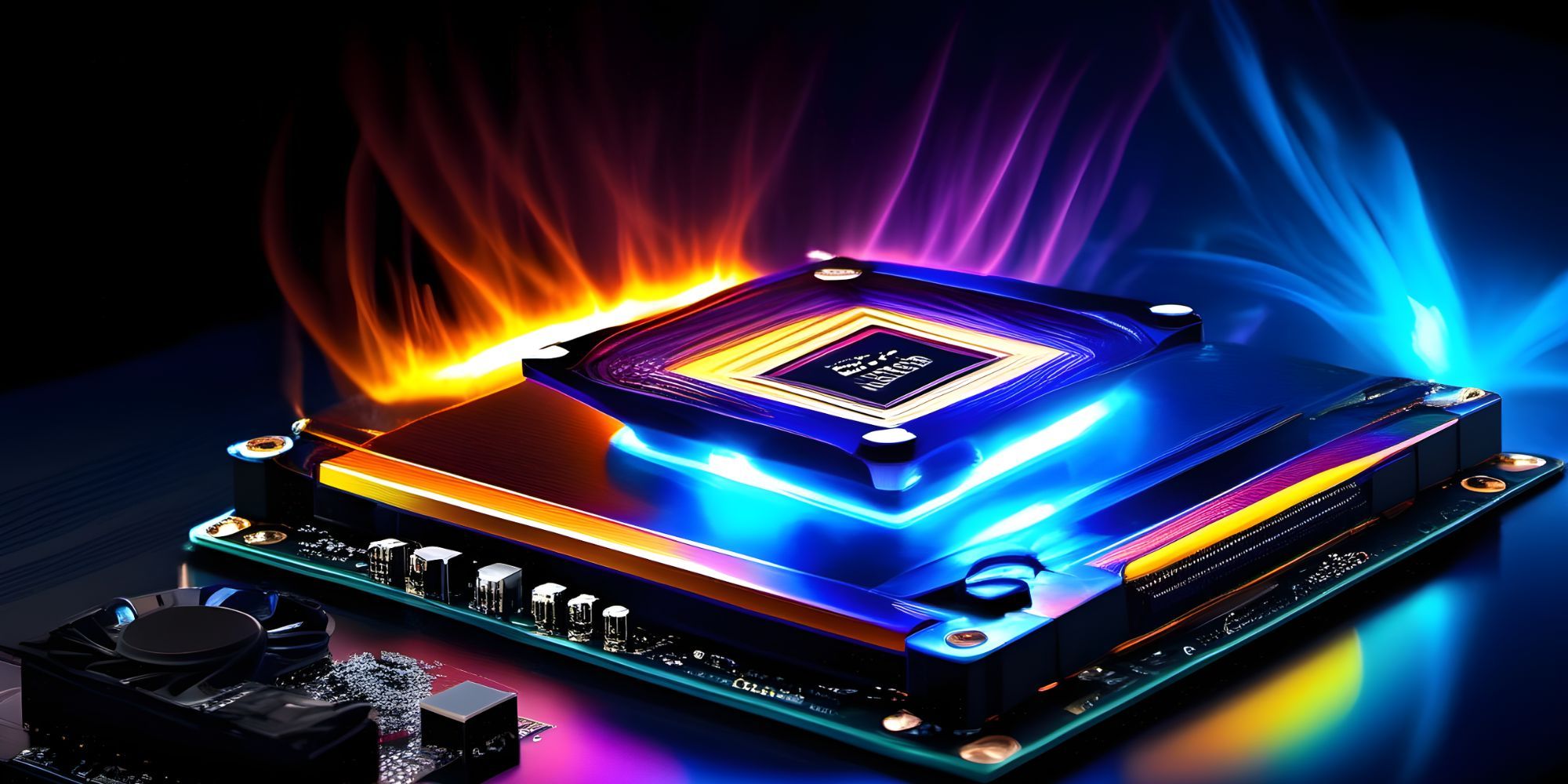
Quick Links
- What Is GPU Overclocking?
- When To Overclock Your GPU
- Risks And Considerations
- Preparing Your PC
- Overclocking Your GPU
- Maintaining The GPU Overclock
- Frequently Asked Questions
Overclocking your graphics card can give you a nice performance boost in games and applications without having to spend even a single penny. How? Well, this handy little trick allows you to push your graphics card beyond the default factory settings so that you can get more speed.
RelatedConsole Vs PC Gaming: Which Is Better?
Pitting Consoles and PCs against each other to see who wins!
PostsHowever, overclocking does come with some risks if not done properly, like system instability and overheating. In this comprehensive guide, we are going to go over all the things you need to know to safely overclock your GPU and get some extra performance out of your gaming rig. Check it out below!
What Is GPU Overclocking?
GPU overclocking refers to running your graphics card at a higher clock speed than its default settings. By default, GPUs run at conservative clock speeds determined by the manufacturer. Overclocking increases the clock speed, so the GPU can operate faster and handle more graphics processing. This is going to help you achieve higher frame rates in games and faster rendering in case you're someone who dabbles in creative applications.
The key idea behind overclocking is that the conservative default speeds on your graphics cards actually end up leaving some extra frequency headroom on the table. You can take advantage of this by manually tuning the settings tailored specifically to the rig and push its performance beyond the "one-size-fits-all" default clocks set by the manufacturer.
When To Overclock Your GPU
Now that you understand the basics of what overclocking is, here are some guidelines on when overclocking your GPU can be most beneficial:
- If you need more performance in demanding games: Most fo the new AAA games typically require beefier GPUs to run at maximum settings and high resolutions. In case you see any FPS dips or stutters with these games because of your dated graphics card, overclocking it can help boost frame rates and smooth out performance. Getting those extra 10–15 FPS can improve the game's playability by miles.
- When upgrading to a higher resolution monitor: Moving from 1080p to 1440p or 4K significantly increases the workload on your GPU. Doing a simple overclock on your GPU can help counteract the extra stress of driving more pixels.
- To maximize benchmark scores: For benchmarking enthusiasts, overclocking is part and parcel of chasing high scores. It allows you to show what your hardware is truly capable of and compete with others. If you're someone who likes to keep those numbers up and high, overclocking is definitely an option to consider.
- When you've maxed out other system bottlenecks: Before overclocking the GPU, make sure your CPU and RAM speeds are already optimized. If those components are holding back FPS, overclocking the GPU may not help much until you address other bottlenecks.
- When your particular GPU has lots of OC headroom: Some GPU models simply have more overclocking potential based on the quality of components and chips. If your card is regularly hitting higher OC speeds than averages, take advantage of that extra headroom and go for the overclock!
As long as you do it carefully and within safe parameters, overclocking can be a rewarding way to extract additional performance from your graphics card in scenarios where you need it most. Just be sure to assess if it's genuinely necessary for your purposes before investing the time.
Risks And Considerations
While overclocking can provide really cool benefits to your gaming experience, it does come with some downsides, which you should consider checking out before going any further:
- System instability: Pushing clock speeds too high for your particular GPU's silicon and cooling capabilities often leads to system crashes, driver failures, game crashes, BSODs, and screen artifacting during intense workloads. This is exactly why you have to run intensive stability testing to find the maximum stable overclock level before going for it.
- Increased temperatures: Higher voltages and clock speeds generate additional heat within your gaming rig, and that heat needs to escape ASAP. If your computer doesn't have the cooling system to take the heat, then you can pretty much kiss the GPU goodbye.
- Accelerated hardware degradation - Heavy overclocks that run hardware significantly above spec and generate substantial excess heat can reduce the operational lifespan of a GPU over time.
- Voiding manufacturer warranty - Overclocking is considered "out-of-spec" operation by most graphics card manufacturers and can technically void their warranty coverage, so be extra careful.
Best Ultrawide Gaming Monitors In 2024
If you're interested in buying the best ultrawide monitors for gaming, we've got you covered with all sorts of options!
PostsPreparing Your PC
Before attempting to push your graphics card to higher clock speeds, it's important to make some arrangements with your PC beforehand. This is going to give you enough padding in case things go south:
- Make sure that you have updated to the latest graphics drivers from NVIDIA or AMD. Getting newer drivers improves your chances of being better optimized for overclocking features and stability.
- Consider an aftermarket GPU cooler upgrade. More powerful third-party air or liquid cooling solutions allow your graphics card to run cooler at higher overclocks.
- Ensure your PC case has excellent front-to-back airflow across the GPU's heatsink and a PCB with high CFM intake fans and unrestricted exhaust vents. This is going to create a cooler ambiance for the case and increase stability at the same time.
- Make sure that you benchmark your graphics card at completely stock settings, noting average clock speeds and temperatures. This is gonna give you a baseline for comparing overclocking gains.
- You can also install utilities like GPU-Z, HWiNFO64, or Afterburner to track voltages, clock speeds, temperatures, fan speeds, and power draw in real-time while testing the overclocks.
Overclocking Your GPU
The easiest way to get started with overclocking your graphics card is through software utilities. For beginners, the easiest method is using the first-party tools from NVIDIA or AMD. You can also try checking out third-party apps like Afterburner, which offer more control for advanced overclocking.
Overclocking An NVIDIA GPU Via Control Panel
- Right-click on your desktop and open the NVIDIA Control Panel.
- Go to Manage 3D Settings and increase Power management mode to Prefer Maximum Performance.
- Go to the Change Resolution page and click Customize to create a custom resolution as a test bed.
- Switch to the Adjust Image Settings tab and set Texture Filtering Quality to High Performance.
- Go back to Manage 3D Settings and increase the GPU clock offset slider in +25 MHz increments.
- Run a GPU stress test like FurMark at each step for 15 minutes, checking for crashes or visual artifacts.
- Once stable, increase the GPU voltage offset slider slightly and retest.
- Keep incrementally raising the GPU clock and voltage together until you find the maximum stable overclock.
- Click Apply to save the overclocked profile.
Overclocking An AMD GPU Via Radeon Software:
- Open Radeon Software and go to the Performance tab.
- Click on the Tuning section.
- Slide the Power Limit slider all the way up to max out the power available for overclocking.
- Adjust the fan curve to be more aggressive, so the fans ramp up faster to keep the GPU cooler.
- Scroll down and click on the Manual button under GPU Tuning.
- Slowly increase the GPU Frequency slider in small increments like 25-50 MHz at a time.
- Test stability by running intensive games/benchmarks for 15 minutes after each increase.
- Once stable, increase the GPU voltage by 25-50 mV using the slider and retest.
- Keep slowly raising the frequency and voltage together until you find the max stable overclock.
- Click Apply to save the tuned profile containing your final stable overclock settings.
Overclocking With MSI Afterburner
- Download and install the latest version of MSI Afterburner. The cool thing about this is it works with both NVIDA and AMD GPUs.
- Open Afterburner and go to the "General" tab.
- Raise the Power Limit and Temperature Limit sliders all the way up to their maximum values. This removes some power and thermal throttling.
- Go to the "Fan" tab. Use the curve editor to create a more aggressive fan curve that ramps up RPM faster to keep temperatures lower.
- Switch to the "Voltage/Frequency Curve" tab. Raise the Core Voltage and Memory Voltage sliders slightly to allow for voltage headroom.
- Go to the main "Overclocking" tab. Slowly increase the Core Clock and Memory Clock sliders in small increments like +25 MHz.
- Click the icon in the bottom right to detach the Afterburner monitoring window. Monitor GPU usage, clocks, temps, power, and fan speed.
- Run a GPU stress test like FurMark at each increment for at least 15 minutes, checking for crashes or visual artifacts.
- If instability occurs, increase Core Voltage and Memory Voltage by another small bump and retest for stability.
- Keep slowly raising the clocks and voltages together until you find the maximum stable overclock settings. Optionally, you can also try playing along with the timings, like bumping the memory clock while keeping clock speed the same.
- Click the checkmark icon to apply and save your final stable overclocked profile.
Maintaining The GPU Overclock
Once you've completed the overclocking process and verified stability, it's important to maintain and monitor your graphics card to ensure no issues crop up over time. Here are some overclocking maintenance tips:
- Run stress tests every few months to verify your overclock remains stable.
- Monitor benchmark scores over time, since declining scores likely indicate the aggressive OC is reducing the lifespan of the card.
- Keep an eye on GPU temperatures while gaming. Make sure to increase fan speeds if the temps rise over time due to dust bunnies or heat accumulation.
- Open up your case and thoroughly clean any buildup from the GPU heatsink, fans, and circuit board at least twice a year.
- Consider replacing the GPU's thermal paste every two to three years in case you're working with some heavy OC.
- Tune your overclock profile for intensive new game titles that cause crashes or artifacts. In fact, you can also consider creating a custom profile with lower clocks.
Frequently Asked Questions
What are some signs that the GPU overclock is unstable?
If you come across any unexpected crashes, lockups, benchmark errors, visual artifacts like checkerboard patterns, worse performance, or higher than expected temperatures when stress testing an overclocked GPU, it likely means that the GPU's settings are unstable. To fix this, you can reduce frequencies and voltages incrementally until issues stop occurring to find the maximum stable overclock. Even the smallest of increases can destabilize an OC, so make sure to test thoroughly at each step when pushing the clocks.
Can overclocking damage the graphics card permanently?
Extreme overclocking with recklessly high voltages for extended periods or severely inadequate cooling can potentially lead to permanent silicon damage, but this is highly unlikely. As long as you overclock carefully within safe parameters for your GPU's architecture, gradually increase clocks and voltages while stress testing, and maintain solid cooling, the risk of permanent damage is minimal. Do your homework and don't blindly max out sliders.
Do all GPUs have the same overclocking potential?
No, overclocking potential can vary greatly depending on the graphics card model, with factors like GPU architecture, power delivery quality, cooling solution, and silicon lottery all playing a role. Newer architectures tend to provide more headroom thanks to process improvements, while custom PCBs and robust power phases sustain faster speeds. There's also the fact that some GPUs will simply perform better when overclocked due to random manufacturing variances. The only way to know your card's true limits is to incrementally test overclocks yourself.
Next: Best Gaming Graphics Cards













